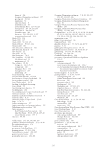22 – Sustainability for the rivers of the Lake Eyre Basin 233 Floodplains can be degraded by intensive grazing of livestock. Large grazing animals can change the structure and composition of vegetation communities, with known impacts on some small mammals around the world (Schieltz and Rubenstein 2016). Our understanding of grazing impacts on floodplain environments remains relatively poor, but they are likely to be fairly minor (Silcock et al. 2013), compared with the impacts of water resource development (Lemly et al. 2000). Other threats continually affect the sustainability of the rivers and their organisms. Climate change, particularly increasing temperatures (Reisinger et al. 2014), is already affecting socio-economic, cultural and environmental dimensions of the Lake Eyre Basin rivers. Increasing temperatures will increase evaporation, narrowing the window for the animals and plants to complete their life cycles as well as increasing the risk of premature drying of waterhole refuges. Further, Channel Country pastures on floodplains are likely to have a decreased duration of productivity while access to water for livestock may be problematic as the persistence of waterholes decreases. This may be partly offset by some evidence for increasing and more intense rainfall (Greenville et al. 2012). Finally, the presence of numerous invasive species threatens the environmental and socio-economic values of the Lake Eyre Basin and demands considerable expenditure by governments and communities (Firn et al. 2015a Firn et al. 2015b). Invasive or alien species include four fish species (see Chapter 3), cane toads (Rhinella marina), the introduced red claw crayfish (Cherax quadricarinatus) from the Australian tropics and various plant species, such as prickly acacia (Vachellia nilotica). One introduced plant species, buffel grass (Cenchrus Fig. 22.2. Networks of complex channel systems that criss-cross the Channel Country of the rivers of the Lake Eyre Basin could be seriously affected by pastoral, farming, mining or road developments.
Downloaded from CSIRO with access from at 216.73.216.187 on Nov 17, 2025, 3:25 PM. (c) CSIRO Publishing

















































































































































































































































































